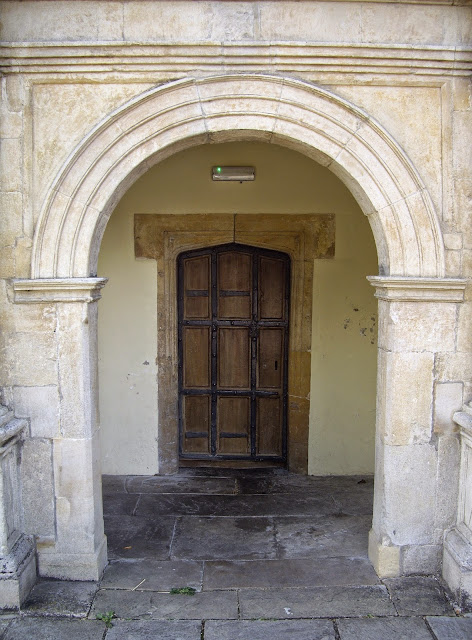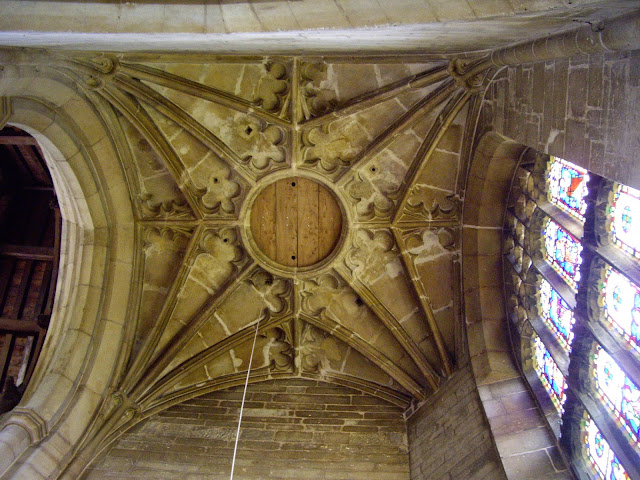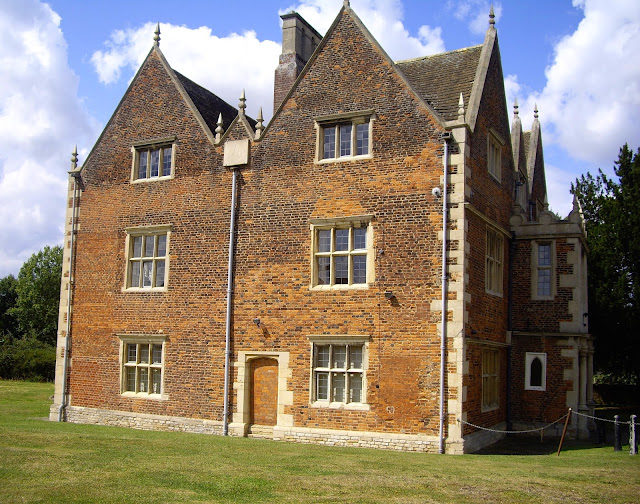The latest in my series of gateways from the series of Serlio's 'Extraordinario Libro di Architettura'.
Sunday, 17 August 2014
Friday, 15 August 2014
Bryan Browning I The House of Correction
The bf was not sure what to expect when standing in Folkingham church yard I told we should go and see 'The House of Correction'. I don't whether or not he was disappointed, or perhaps relieved, (what was he imagining?!) when we took the road to Billingborough and stopped on the very edge of the village to look at this.
What you're looking at this the remaining portion of a gaol built in 1825 by the remarkable local architect Bryan Browning. (I have already mentioned his son Edward in connection with Folkingham church.) Browning was born in Lincolnshire in Northorpe, just south of Bourne, and really not much else is known about him. He trained in London under, I think, Thomas Hardwick. He lived in Brunswick Square in Bloomsbury for a while and then returned to Lincolnshire, practicing in Stamford. He built a small number of powerful buildings in and around south Lincolnshire: Bourne Town Hall, the Stamford Institute, the workhouses in Bourne and Stamford, and a number of rectories such as at Deeping St James, and this 'The House of Correction'. It shows the influence of Vanbrugh and Ledoux - English Baroque and French Neo-classicism - not a bad mix for a provincial English architect. It is now a holiday let owned by the 'Landmark Trust'.
Wednesday, 13 August 2014
Folkingham
After leaving Aslackby we drove a couple of miles north to the understated beauty of Folkingham. What makes it such an attractive village (apart from Hansen's Chocolate House!) is the immense green or market place. Roughly triangular, it has been laid out on a south facing slope, (in the Middle Ages, I presume), and is lined with attractive, but not flashy, eighteenth century houses. Presiding over everything at the top of the hill is great red brick bulk of the former Greyhound Inn - a Georgian coaching inn with assembly room attached (right hand side in photograph). At the bottom of the hill the fine stone built manor house that also served as a courthouse. I think the Assize Courts used to sit there, hence the Assembly Room at the Greyhound; Folkingham, then small market town, becoming a social hub for the local gentry when the court was session.
Tucked away at the side is the parish church of St Andrew. The tower is particularly fine. It seems to belong to the same family as the towers of St John and St Martin Without both in Stamford.
Inside the tower has a tierceron vault very similar to that at Morton. And just as at Morton and Aslackby there is a lot of fine ashlar masonry above the arcades. Quite an extravagant thing to do when you consider that originally it would be whitewashed and painted.
Tucked away at the side is the parish church of St Andrew. The tower is particularly fine. It seems to belong to the same family as the towers of St John and St Martin Without both in Stamford.
Inside the tower has a tierceron vault very similar to that at Morton. And just as at Morton and Aslackby there is a lot of fine ashlar masonry above the arcades. Quite an extravagant thing to do when you consider that originally it would be whitewashed and painted.
Labels:
churches,
Edward Browning,
Folkingham,
Limestone Belt,
Lincolnshire
Monday, 11 August 2014
Kaffe Fassett at St James, Aslackby
On Saturday the bf and I returned to Aslackby where the church had been transformed into an exhibition space for a display of the quilts - 'Glorious Quilts' - by the multi-talented Kaffe Fassett. The manor house garden was also open, there was tea and cake, ice cream, honey for sale, and the man himself was autographing books. The weather was about perfect, with a sweet melancholic hint of approaching autumn.
The quilts, which were created over a number of years, were hung in the arches of the nave arcade, on the aisle walls and one was hung below the east window; it was curious how the context changed the quilts. They ceased to be bedroom accessories - if ever they were merely that - but were turned into tapestries. It somehow connected to the long tradition of fabrics in Churches, which has generally been forgotten about. Even some of the patterns gained something, I think it's called 'signification', in their new context.
The quilts, which were created over a number of years, were hung in the arches of the nave arcade, on the aisle walls and one was hung below the east window; it was curious how the context changed the quilts. They ceased to be bedroom accessories - if ever they were merely that - but were turned into tapestries. It somehow connected to the long tradition of fabrics in Churches, which has generally been forgotten about. Even some of the patterns gained something, I think it's called 'signification', in their new context.
This quilt hung below the east window. It fitted perfectly. There's something about it that suggests Italian Pietra Dura. It was one of my favourites.
Like a Opus Alexandrium pavement.
I had a go at trying to juxtapose the quilts in a single photograph. The colours seem so typically Fassett - the vivid blues and pinks.
Only in writing this and selecting the images have I been struck by the potential contrast between the coolness and stasis of the architecture and the vivid, vibrant quilts. It was something I wasn't so aware in the experience. My favourites were the more abstract (one or two contained a representational images and were not so successful), and which had the smaller pieces of fabric. Not being a quilter I don't know the technical word. If there is one. I also preferred the pattern on the pieces of fabric 'small'. Perhaps it might be said that my favourites were those that I found made reference to architectural pattern. It would have been interesting to know if the ones I particularly like all dated from the same time. Interesting too to try to have put the quilts into a date sequence simply by comparing their design. I wonder if that was possible. In the guide there's a quote from Kaffe Fassett: "Working with your hands brings sanity and bliss." It's hard, very hard to disagree.
We had to have a look around the garden. The herbaceous borders had grown blousy and overgrown, the trees heavy with fruit.
By the way, the honey, which is from the hives in the Manor House garden, is quite delicious - mild and fragrant.
Labels:
Aslackby,
Folkingham,
gardens,
Kaffe Fassett,
Lincolnshire
Thursday, 7 August 2014
The Red Hall, Bourne, Lincolnshire
The Red Hall in Bourne dates from the early years of the 17th century. As with the Hall at the near-by village of Dowsby the Red Hall has parallels with designs found in the album of John Thorpe (1565-1655?), a surveyor in the Office of Works. Thorpe's father was a master mason (he worked at Kirby Hall, Northants); his son has been credited with designing not only the Red Hall and Dowsby Hall, but Carlton House, Condover Hall, Longford Castle, Holland House and (in part) Audley End and Rushton Hall. The Hall has also been erroneously linked with the Gunpowder Plot, and there are stories of tunnels leading from various buildings in the town to the hall.
Oddly the hall had another life as the ticket office, and Station Master's house, of Bourne Station. It was rescued from demolition in the 1960s after the station was closed in 1959. (There were lines north to Sleaford, east to King's Lynn and Norwich, south west to Essendine on the main line, and west to Leicester.) The architects of the restoration were Bond & Read. It is still possible to detect, after four decades, what they did - look for the changes in the colour of the bricks. The Hall is administered by Bourne United Charities, and is now used for wedding receptions, exhibitions, and the like. Unfortunately the planned formal garden thta was planned was not undertaken and now the Hall, which apart from the entrance façade is perhaps a little gaunt, stands a bit forlorn in a sea of mown grass.
The entrance facade: the two windows on the ground floor on either side of the porch date from the 1960s restoration replacing wooden bay windows, but as you can see retained the bay window on the side elevation (it lights the council chamber). The builders however inserted the transom in the right window upside down!
The porch - the best feature of the Hall. A lovely design and a contrast to the brickwork.
 |
The inner door to the porch - a small example of 'Gothic Survival'
Labels:
Bourne,
Country Houses,
Jacobean,
John Thorpe,
Lincolnshire,
The Red Hall
Sunday, 3 August 2014
Cambridgeshire Open Studios 2014
We left Wales on Friday, but instead of returning straight home I spent the weekend with the bf on the Isle of Ely. One of of my favourite things each year is the 'Cambridgeshire Open Studios' which takes place in July. So after a lazy Saturday we spent Sunday in the car and visited four studios in and around Ely plus Angela Mellor's studio/gallery which also open but not part of the scheme.
Angela Mellor is a ceramicist working in bone china and producing the most delicate if not ethereal objects. Her beautiful gallery space too is worth a visit for its own sake.
We then drove to Little Downham to two studios: firstly Andy English, and then Phil Treble. Andy English is a wood engraver and illustrator and produces wonderful things like this 'Prospect of Ely which was designed, engraved, printed and bound by Andy himself in a limited edition of 100. He uses a Victorian Albion Press.
Andy English works in what originally was his garage as does Phil Treble. Phil is a letterpress printer, though during the week he designs stuff for the internet.
We then drove to Little Downham to two studios: firstly Andy English, and then Phil Treble. Andy English is a wood engraver and illustrator and produces wonderful things like this 'Prospect of Ely which was designed, engraved, printed and bound by Andy himself in a limited edition of 100. He uses a Victorian Albion Press.
Andy English works in what originally was his garage as does Phil Treble. Phil is a letterpress printer, though during the week he designs stuff for the internet.
Corinne Blandin-Eagling does not work in a garage or a shed; she works in a bright yellow double-decker bus which is parked in her back garden in Barway. "You're aboard, You're aboard. You're aboard with the Double Deckers..." Barway is a remote place, a 'dead-end', with a small village green and old houses; at the far end of the village is a wonderful old hump-backed bridge and a delicious view of Ely Cathedral. I hope she won't be insulted if I say that it's all wonderfully eccentric chez elle. Corinne does a wide range of courses including pottery.
Finally we drove to Burwell and the hidden away studio of James Ryder, letter cutter, who trained at the Kindersley workshop. The studio is literary up the garden path - possibly the best commute I know. It was Phil Treble who printed James's wonderfully tactile business cards.
Heading back to Sutton we caught the last few minutes of Jarvis Cocker's evocative documentary on 'Betjeman's Banana Blush' - the album of late Poet Laureate reading his work to musical accompaniment by Jim Parker. The album was produced by Hugh Murphy. It was released in 1974 on the Charisma label. All rather eccentric, and quite, quite fantastic. I urge you to go and get a copy or listen to both it and the documentary on-line. It's well worth it. Betjeman, I think, was the last Poet Laureate to really connect with people (that is usually prefaced with 'ordinary', but I'll dispense with that slightly lit snobbish term). But enough said about that.
Angela Mellor www.angelamellor.com
Andy English www.andyenglish.com
Phil treble www.muttonsandnuts.co.uk
Corinne Blandin-Eagling www.corinneblandin.com
James Ryder www.jamesryderlettercutter.co.uk
Finally we drove to Burwell and the hidden away studio of James Ryder, letter cutter, who trained at the Kindersley workshop. The studio is literary up the garden path - possibly the best commute I know. It was Phil Treble who printed James's wonderfully tactile business cards.
Heading back to Sutton we caught the last few minutes of Jarvis Cocker's evocative documentary on 'Betjeman's Banana Blush' - the album of late Poet Laureate reading his work to musical accompaniment by Jim Parker. The album was produced by Hugh Murphy. It was released in 1974 on the Charisma label. All rather eccentric, and quite, quite fantastic. I urge you to go and get a copy or listen to both it and the documentary on-line. It's well worth it. Betjeman, I think, was the last Poet Laureate to really connect with people (that is usually prefaced with 'ordinary', but I'll dispense with that slightly lit snobbish term). But enough said about that.
Angela Mellor www.angelamellor.com
Andy English www.andyenglish.com
Phil treble www.muttonsandnuts.co.uk
Corinne Blandin-Eagling www.corinneblandin.com
James Ryder www.jamesryderlettercutter.co.uk
Subscribe to:
Comments (Atom)


































